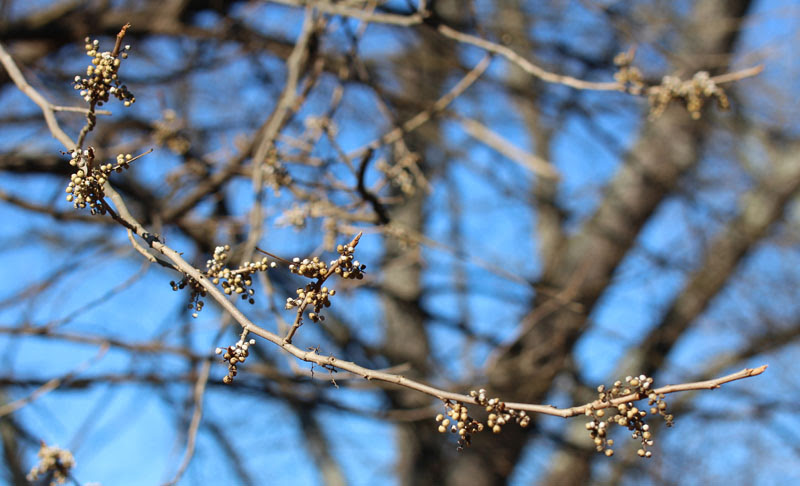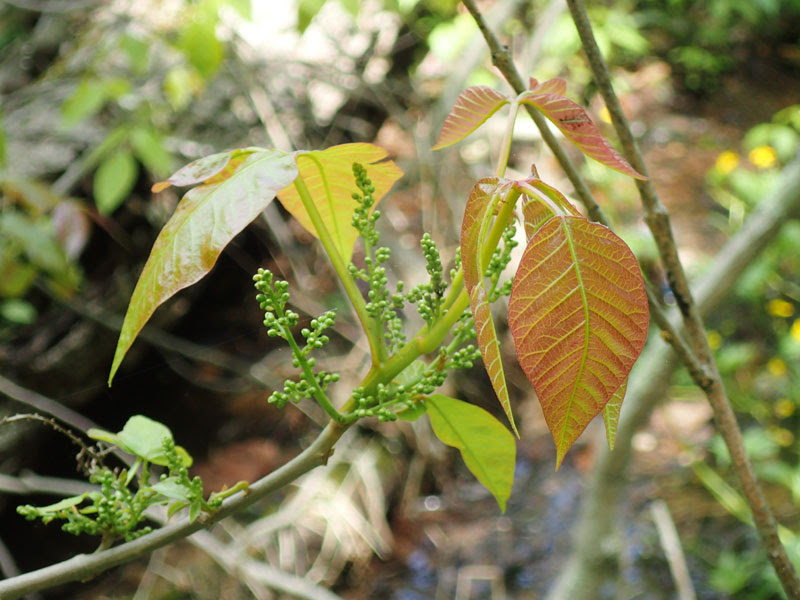Do you know Rebbe Rhus toxicodendron? Reb Rhus’s ancestors hail from the family Anacardiaceae, cousins to mangos, cashews and staghorn sumac trees. Like human beings, Reb Rhus, more coarsely known as “poison ivy,” migrated across the temperate and warm regions of the earth. When starting a new garden, consult the Rebbe Rhus, as she may be standing nearby.
In every season Reb Rhus holds forth, inviting us to pay attention to every little detail on the ground or at our eye level, above and below. She is the rabbi of the Torah of Everything Belongs.
In early spring, she’ll offer a little wood rash (woo drash?), an especially challenging lesson. What does this mean for you, starting a new garden at the edge of a tree line? Pay attention to any gentle touch of her finger. Rebbe Rhus, nerve dendrite of the woods, speaks for the trees, her podium a single synapse where your garden might grow.
Rhus’s flowers are tiny greenish-yellow clusters, pollinated by bees, ants, beetles, flies, moths and butterflies. Once pollinated, the flowers morph into waxy, creamy-white berries which in fall and winter are consumed by dozens of species of songbirds, as well as other wildlife. The berries contain a high fat content that keep those that consume the plant warm through the winter, which then disperse the seeds to new locations via their scat.

A slight brush against her skin, a slender stem of pale bark, a mustardy-sandpaper bud, not yet broken, will soon re-remind you that everything in the universe gets to be here. Her potent voice carries through even in winter, scary, hairy stem, no leaves, asking for your membership dues to belong in this place with her.
If you’re counting the Omer you may have been contemplating the quality of tiferet (beauty, balance, compassion) this week. So, if you contact the Rebbe this week, you may want to perform the cleansing ritual while trying to stay in the mindset of tiferet. Peel off the afflicted garments you wear and wash them with strong soap. Urushiol is the name of the plant’s thick oil that binds to skin like tefillin and what interacts with our skin to produce an intense immune reaction that makes you itch.

Urushiol serves the plant by sealing up wounds garnered by browsing animals. You, however, really need to wash it off fast. If you suspect you’ve been tapped, perform your mikvah as soon as is practical (and ideally within 10-15 minutes). Or, more appropriately, keep around some Technu or Zanfel because it will work tons better than the stuff they used to treat the skin plague during biblical times. If things are looking bad, call your doctor.
The urushiol binds quickly to your skin; any dermatitis reaction will be yours alone so you need not dwell alone outside away from others until you are healed. If the tzaraat recurs, the entire garment must be washed again, but not destroyed in any other ritual manner.
As we learn from the Torah this parshah about the laws of tumah v’taharah, the rituals of purity and impurity, may we seek not perfection in our gardens but an awareness of the holiness within all beings and acceptance for the imperfect and the unpleasant. You might consider the relentless sermon of Reb Rhuss that it is not your ground alone to make what you will there, but a shared, mysterious and free place for all beings.

May we be sanctified this Shabbat by the awareness that all beings are connected and share in each others’ destruction as we do in our thriving. Leaves of three, let them all be.
This post has been contributed by a third party. The opinions, facts and any media content are presented solely by the author, and JewishBoston assumes no responsibility for them. Want to add your voice to the conversation? Publish your own post here. MORE


